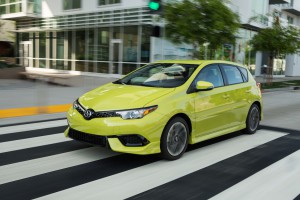
Once one of the hottest, hippest brands on the U.S. automotive market, Scion is hoping to reinvent itself with the launch of two new models this coming year, the iM and iA. And, in an unusual turnabout, it has sought help from little Mazda.
First launched 12 years ago, Scion was designed to reach the sort of youthful trendsetters who were largely steering clear of parent Toyota’s showrooms. And, with quirky models like the xB backed by creative – if sometimes dark – marketing campaigns, the brand became an almost instant success, hitting a 2006 peak with sales of 173,000 vehicles.

But Like a parent who tries to pick up on the latest teenage slang, Scion soon seemed to disconnect with hip audience it sought. The second-generation xB, specifically designed for the U.S. market, was a spectacular flop and, by 2014, sales plunged to a mere 58,000. The slide has continued this year. Despite the ongoing revival of the U.S. new car market, Scion sales dipped another 18.6% during the first half.
Hoping to rebuild momentum, “We’re taking a look at everything we’re doing as a brand,” said Scion General Manager Doug Murtha, during a media preview in Grand Rapids, Michigan.

Among other things, the Toyota subsidiary is lightening up some of its marketing efforts, hoping to reconnect with a new generation it believes is more upbeat and optimistic – despite college debt and job problems – than the one that bought the first Scion products.
The product line-up also is being transformed, with less emphasis on what Murtha said were “vehicles very off-the-reservation.”
The two new models for 2016 include both the iM hatchback and Scion’s first-ever sedan, the iA. In an unusual move, the maker turned to a partner for that edgy four-door model, little Mazda. The Scion iA is a thinly restyled version of the Mazda2 and the two will be produced side-by-side at Mazda’s new plant in Mexico.
(Scion uses alphabet soup to punch up new models. For more, Click Here.)
The addition of a sedan to a line-up that traditionally focused on more aggressive coupes, sports cars and quirky box-mobiles like the xB has taken some observers by surprise. But Murtha is confident it will bring in a different type of youthful buyer. The iM hatchback will target a more traditional Scion customer.
All told, Scion will have four products to offer at the start of the 2016 model-year, itself a shift from the original brand strategy that called for offering no more than three models at a time. Along with the two new entries, Scion will carry over the tC coupe and FR-S, a sports car developed as part of another partnership with Subaru.

While Scion will never have the broad line-up of its parent Toyota, “four, five, six (different models) is what I see doing going forward,” Murtha said.
(Click Here to see why nine of 10 Millennials says car ownership is important.)
While the brand may have more models than at its peak, a decade ago, it has downsized its aspirations, perhaps in keeping with the under-35 buyers it covets.
“To be sustainable and viable as a brand, we need to be selling north of 100,000 vehicles,” said Murtha, quickly adding, “We’re never going to push this thing above 200,000.”
Whether the maker can even hit its current sales goal is far from certain. It will have to rebuild momentum at a time when the rebound of the overall U.S. market is slowing down. And it is targeting a generation of buyers who have been notoriously ambivalent about owning an automobile.
(Mazda or Scion? Alliances are changing the auto industry. Click Here for the story.)
But Scion’s parent sees that as critical. Toyota built its brand on the Baby Boom generation and knows that it needs to find a way to tap that new generation if it’s going to retain its own momentum in the years ahead.








“Like a parent who tries to pick up on the latest teenage slang”
Nailed it. (sic)
If you run around saying how cool you are, you aren’t